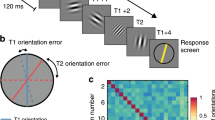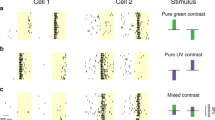Abstract
MCCOLLOUGH1 discovered that if a grating pattern of (say) red vertical stripes is viewed alternately with one of green horizontal stripes for some minutes, an orientation-specific colour after-effect is observed when viewing a black-and-white test grating. White stripes in a given orientation appear tinted with the hue complementary to the hue presented at that orientation in the original stimulus. McCollough observed that if only one eye was exposed to the original sequence of stimuli, no after-effect was seen when the other eye was used to view the test grating. From this she concluded that the adaptation responsible for the after-effect must occur somewhere in the uniocular pathway before signals from left and right eyes are combined. She suggested as a possible explanation that orientation-sensitive channels in the uniocular nervous system (“edge-detectors”) may be colour-coded, so that strong adaptation with bars of red light in one orientation leads to a “minus-red” after-response from the adapted channels to similarly oriented colourless bars. Harris and Gibson2 have confirmed that the effect persists in conditions ruling out ordinary negative afterimages, which Murch and Hirsch3 have shown sufficient to induce it. Held and Shattuck4 have demonstrated a corresponding after-effect of colour upon the perceived orientation of test bars.
This is a preview of subscription content, access via your institution
Access options
Subscribe to this journal
Receive 51 print issues and online access
$199.00 per year
only $3.90 per issue
Buy this article
- Purchase on Springer Link
- Instant access to full article PDF
Prices may be subject to local taxes which are calculated during checkout
Similar content being viewed by others
References
McCollough, C., Science, 149, 1115 (1965).
Harris, C. S., and Gibson, A. R., Science, 162, 1506 (1968).
Murch, G. M., and Hirsch, Joy+nm>, Amer. J. Psychol., 85, 241 (1972).
Held, R., and Shattuck, S. R., Science, 174, 314 (1971).
Creed, R. S., J. Physiol., 127, 381 (1935).
Suzuki, H., and Takahashi, M., Brain Research, 23, 161 (1970).
Sanderson, K. J., Bishop, P. O., and Darian-Smith, I., Exp. Brain Res., 13, 178 (1971).
Noda, H., Tamaki, Y., and Iwama, K., Brain Research, 41, 81 (1972).
Author information
Authors and Affiliations
Rights and permissions
About this article
Cite this article
MACKAY, D., MACKAY, V. Orientation-sensitive After-effects of Dichoptically Presented Colour and Form. Nature 242, 477–479 (1973). https://doi.org/10.1038/242477a0
Received:
Published:
Issue Date:
DOI: https://doi.org/10.1038/242477a0
This article is cited by
-
A differential equation model for the stage theory of color perception
Japan Journal of Industrial and Applied Mathematics (2022)
-
Orientation specific colour adaptation at a binocular site
Nature (1976)
-
A neural network model of the McCollough effect
Biological Cybernetics (1976)
Comments
By submitting a comment you agree to abide by our Terms and Community Guidelines. If you find something abusive or that does not comply with our terms or guidelines please flag it as inappropriate.



